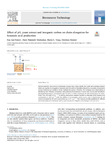| dc.contributor.author | San-Valero, Pau | |
| dc.contributor.author | Nalakath Abubackar, Haris | |
| dc.contributor.author | Veiga, María Carmen | |
| dc.contributor.author | Kennes, Christian | |
| dc.date.accessioned | 2024-01-31T18:29:38Z | |
| dc.date.issued | 2019-12-29 | |
| dc.identifier.citation | Pau San-Valero, Haris Nalakath Abubackar, María C. Veiga, Christian Kennes, Effect of pH, yeast extract and inorganic carbon on chain elongation for hexanoic acid production, Bioresource Technology, Volume 300, 2020, 122659, ISSN 0960-8524, https://doi.org/10.1016/j.biortech.2019.122659. (https://www.sciencedirect.com/science/article/pii/S0960852419318887) | es_ES |
| dc.identifier.issn | 0960-8524 | |
| dc.identifier.uri | http://hdl.handle.net/2183/35300 | |
| dc.description.abstract | [Abstract] Several anaerobic bioconversion technologies produce short chain volatile fatty acids and sometimes ethanol, which can together be elongated to hexanoic acid (C6 acid) by Clostridium kluyveri in a secondary fermentation process. Initiatives are needed to further optimize the process. Therefore, five strategies were tested aiming at elucidating their influence on hexanoic acid production from mixtures of acetic acid, butyric acid and ethanol. pH-regulated bioreactors, maintained at pH 7.5, 6.8 or 6.4 led to maximum C6 acid concentrations of, respectively, 19.4, 18.3 and 13.3 g L−1. At pH 6.8, yeast extract omission resulted in a decrease of the hexanoic acid concentration to 12.0 g L−1 while the addition of an inorganic carbon source, such as bicarbonate, for pH control, increased the C6 acid concentration up to 21.4 g L−1. This research provides guidelines for efficient improved production of hexanoic acid by pure cultures of C. kluyveri, contributing to the state of art. | es_ES |
| dc.description.sponsorship | The authors acknowledge the financial support from the Spanish Ministry of Economy, Industry and Competitiveness (MINECO) through project CTQ2017-88292-R, as well as through European FEDER funds. PSV acknowledges the contract granted by Generalitat Valenciana for her post-doctoral stay at UDC (La Coruña, Spain, APOSTD/2017/121). HNA thanks the Xunta de Galicia (Spain) for his post-doctoral contract (ED 481B-2016/195-0). The authors belonging to the BIOENGIN group at UDC thank the Xunta de Galicia for its financial support to Competitive Reference Research Groups (GRC) (ED431C 2017/66) | es_ES |
| dc.description.sponsorship | Generalitat Valenciana; APOSTD/2017/121 | es_ES |
| dc.description.sponsorship | Xunta de Galicia; ED 481B-2016/195-0 | es_ES |
| dc.description.sponsorship | Xunta de Galicia; ED431C 2017/66 | es_ES |
| dc.language.iso | eng | es_ES |
| dc.publisher | Elsevier | es_ES |
| dc.relation | info:eu-repo/grantAgreement/AEI/Plan Estatal de Investigación Científica y Técnica y de Innovación 2017-2020/CTQ2017-88292-R/ES/VALORIZACION DE RESIDUOS PARA LA PRODUCCION DE ALCOHOLES, ACIDOS ORGANICOS Y BIOPOLIMEROS | es_ES |
| dc.relation.uri | https://doi.org/10.1016/j.biortech.2019.122659 | es_ES |
| dc.rights | © 2019 Elsevier Ltd. All rights reserved. | es_ES |
| dc.subject | Caproic acid | es_ES |
| dc.subject | Clostridium kluyveri | es_ES |
| dc.subject | Chain elongation | es_ES |
| dc.subject | Medium chain fatty acids | es_ES |
| dc.title | Effect of pH, Yeast Extract and Inorganic Carbon on Chain Elongation for Hexanoic Acid Production | es_ES |
| dc.type | info:eu-repo/semantics/article | es_ES |
| dc.rights.access | info:eu-repo/semantics/embargoedAccess | es_ES |
| dc.date.embargoEndDate | 9999-99-99 | es_ES |
| dc.date.embargoLift | 10007-06-07 | |
| UDC.journalTitle | Bioresource Technology | es_ES |
| UDC.issue | 300 (March 2020) | es_ES |
| UDC.startPage | 122659 | es_ES |
| dc.identifier.doi | 10.1016/j.biortech.2019.122659 | |






